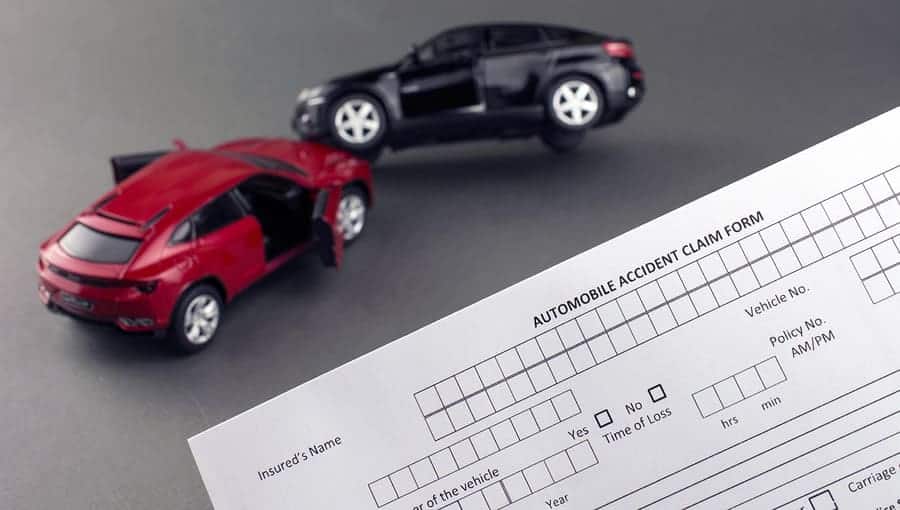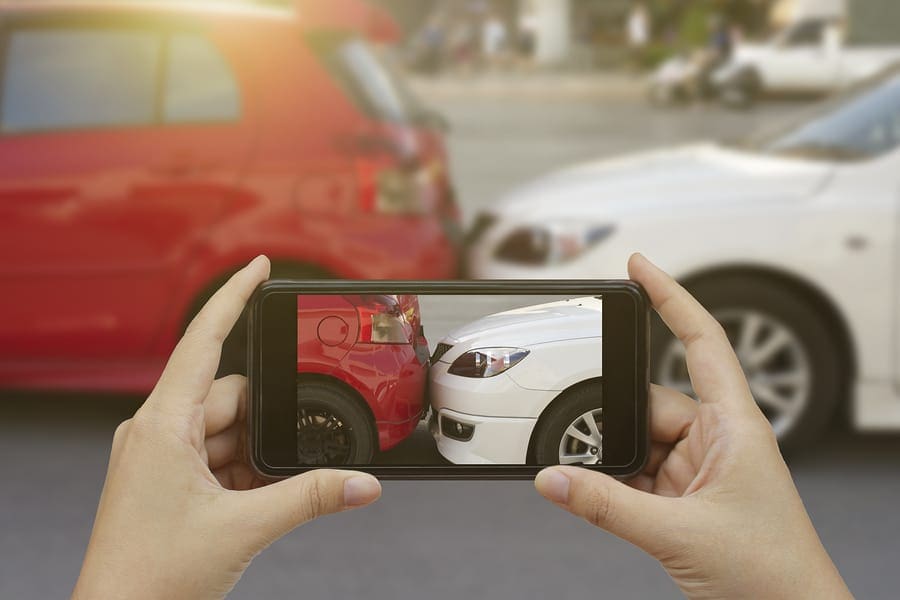If you were hit from behind, you’re probably wondering what to do when you get rear ended. You also probably want to know how to determine liability, when you should seek medical attention, and what your rear end collision settlement might look like whether or not you hire a car accident lawyer.
What Is A Rear End Collision and How Do They Happen
A rear end collision is defined as when one or more vehicles crash into the back of another vehicle. Rear end collisions are among the most common types of accidents on the road, along with side impacts (between two cars) and frontal/head on collisions (into the front of a car). According to data from 2020 in the US, about 29% of all accidents reported were rear-end collisions.
The most common reason rear end collisions happen is the driver in the back is driving too closely to the car in front. It also is common for distractions to cause these accidents. Many rear end collisions are caused by cell phone use, talking to others in the vehicle or changing the radio. Poor weather also can cause rear end crashes.
Following too closely is a common cause of such accidents. When you follow too closely, it takes longer for your car to stop and if the driver in the front slams on the brakes at a stop sign or red light, you may not be able to stop in time and rear end that vehicle.
According to reporting from the National Highway Traffic Safety Administration, about 29% of all accidents reported were rear-end collisions, making them the most common type of traffic accidents on the road.
However, in some cases, you may have been stopped when another driver hit your car from behind. This could be the case with a tailgater who hits your vehicle while stopped at an intersection
How Common Are Rear End Collisions?
Rear end collisions are one of the most common on American roads. It is estimated that 1/3 of all highway accidents are rear end collisions. A rear end accident occurs when the lead driver in an auto accident strikes another car in front of it, often as a result of speeding or distracted driving.

- How Much Is Your Car Accident Settlement Worth?
Find out the maximum compensation you could receive.
- How Much Is My Car Accident Settlement Worth?
A rear end accident can happen to anyone, anytime and anywhere, and can cause a wide range of injuries. However, there are a few places where they occur more often, especially if the roads are crowded or congested with a lot of traffic. The most common places for a rear end collision would include:Where Do Most Rear End Collisions Happen:
- In an intersection – The most common place to be rear ended is while stopped at a red light or stop sign, usually
- In heavy traffic – if you don’t have enough time to stop safely in front of another vehicle, then it might back into you. It’s the same reason that red light collisions happen quite often at intersections with shorter yellow signal lights , especially in places where there are a lot of drivers running red lights.
- On a freeway – while you might think that the speed limit on freeways would make rear end collisions less likely, it’s actually quite difficult to stop in time no matter how far back you are. This is especially true if you’re driving at night and the driver behind has their high beams turned on (they won’t see your brake lights), or if the road is wet and slippery .
The most important thing to remember in a rear end collision is that your car insurance claim is going to be based on who was at fault.
If you were not obstructing traffic when hit from behind, then it’s likely that the damage would be considered “not your fault.” However, if you were stopped for a person running a red light and unable to avoid being hit, then the accident would be considered your fault.
Common Injuries Suffered in Rear End Collisions
Whiplash: Whiplash is a type of neck injury that might occur if you’re rear ended. The impact forces your head to move quickly, which can cause strains and tears in the muscles around your neck as well as within your spine. Neck pain can continue for weeks or even months following a whiplash injury.
Concussion/Traumatic Brain Injury: If the accident was serious enough, you could suffer a concussion or traumatic brain injury. In auto accidents, concussions often occurs in conjunction with whiplash due to the brain rattling around inside the skull, but also happens when the crash causes someone’s head to hit the steering wheel or dashboard and can result in ongoing effects such as: dizziness, headaches and nausea.
Soft Tissue Injuries: Since the impact of a rear end collision is often to your neck and back, you might suffer injuries like soft tissue damage around those parts of your body. These can include bruising, lacerations and scrapes.
Lower Back Injuries: Getting rear ended can cause serious lower back injuries, including a disc herniation within your spine that often occurs. This occurs when the ligaments surrounding the discs detach and move towards the outside of your spine, which can also result in pain down one or both legs.
What To Do After Getting Rear Ended
A list of what to do after a rear end collision can be broken into 3 stages: The immediate aftertermath, the “fixing” stage, and the “car accident settlement” phase. We’ll discuss all 3 in depth below.
Immediate Aftermath of a Rear End Accident
If you’ve been involved in a rear end collision, or any autoaccident for that matter, you should always take the following steps to ensure immediate safety, as well as fair compensation for your injuries, lost wages, and property damage later.
- Check for serious injuries: First things first, take a deep breath and remain calm. After that, you should check any signs of bodily injury on yourself and passengers. If you think you are injured at all, you should go to a hospital right away to seek medical attention.
- Move your vehicle and any occupants to safety as soon as possible. Car accidents can often lead to further accidents because of rubbernecking and other drivers paying attention to the accident scene instead oif the road ahead.
- Don’t admit fault: This should be self explanatory, but it’s important. Never admit fault, especially in a police report or to an insurance provider – yours or the at fault driver’s insurance policy representatives.
- Call the police and file an accident report: Filing a police report is a very important step if you’re planning on filing a car accident claim down the road. It’s an official record, signed off by a local police officer, of how the accident occurred, which driver or drivers were found at fault, and any traffic violations that the police officer noted may have contributed to the rear end collision, such as speeding or reckless driving. Make sure you get contact information for any police officers involved in the scene or accident report – this can be important if you have questions or need confirmation later.
- Take photos of the scene any damage to your car. Next, fully document your property damage. Take photos of your car and the one that struck you, as well as anything at the the scene of the accident that may have contributed to the rear end crash. Take pictures of the road conditions as soon as you can after the rear end accident. This will
- Gather information and exchange contact info with all involved drivers and witnesses. In a rear end accident there can be multiple cars involved, so get as many points of contact from as many other vehicle occupants as you can. Even if the person wasn’t a driver of one of the involved vehicles, their testimony could be key to helping you and the insurance company understand what happened and which driver was at fault.
Seek Medical Attention
If you’ve been injured in a rear end collision, even just a little soft tissue damage, it’s important to seek medical care as soon as possible after the accident. This will be important for your injuries, of course, but it can also help you to gather documentation of your injury.
So, if you know that you hit your head in the accident or had some other bodily injury as a result of the rear end crash, go get checked out immediately. If there’s any question about whether or not the medical attention you receive after your accident is related to the rear end collision, ask.
“Fixing” Your Rear End Collision
This part of a “what to do after a rear end crash,” discussion involves getting back on the road as soon as possible and making everything right with your car. Fixing your car will help keep your mind clear and allow you to focus on your physical recovery and getting a fair settlement to cover your medical expenses and property damage.
How Is Fault Determined In a Rear End Collision?
Of course, how much you are compensated in your rear end collision settlement depends on who was at fault. Laws at the state and federal level, as well as insurance company rules, favor the front driver that was struck from behind in most instances. Most of these crashes are blamed on the driver in the rear. Driving rules state that all drivers must follow cars in front of them at a safe distance.
But that doesn’t mean the rear driver is always the at fault driver in rear end accidents. Poor visibility or road conditions can be factors in a rear end crash. Also, there are some auto accidents that could be at least partially blamed on the front car. If the front driver was distracted by texting on a cell phone and slams on the brakes to avoid hitting a child in the street, it is possible he could be deemed partially at fault for the accident.
Speak to a Personal Injury Attorney
It’s always a good idea to speak to a personal injury attorney about your claim. After an auto accident, it is important to speak to an experienced car accident lawyer before speaking to any insurance company or taking any legal action. A lawyer can help you determine if the other driver was at fault and advise you on the best way to proceed with your claim, or file a lawsuit if the car accident settlement offer .
Lawyers often charge on contingency, meaning they only get paid if you do, so they want to make sure you have a good case before they commit to taking it. Because of this, it’s rare to find an injury law firm that doens’t offer a free consultation. This is a great way to learn more about your legal options, without any obligation, because the law firm has a financial interest in finding good cases too. A free case evaluation is a good idea for both you and your prospective attorney to find out about the details of the accident and discuss how strong your case is.
It’s worth taking the time to make sure you find the right personal injury attorney for your specific rear end collision case. While it may seem overwhelming, here are a few tips to help you find the right law firm after your rear end accident:
- Read Reviews: A lot of people go online to find reviews for lawyers. You can read them on the internet, on yelp, even law firm websites sometimes have testimonials.
- Check the Bar Association: Bar association websites contain a lot of helpful information. Just type in the attorney’s name (or bar number if you have it), and you’ll be able to see whether or not that lawyer has an active license to practice law, if they’ve had any suspensions or other disciplinary actions taken against them, and if they have any specializations or group memberships.
- Make sure they have experience handling rear end car accident cases: A lot of lawyers will say they handle personal injury, but that doesn’t necessarily mean they’ve dealt with cases like yours. Make sure they’re experienced in handling rear end collisions before hiring them.
- Ask about their fee structure: Typically, a personal injury law firm will charge between 25% and 40% of the final car accident settlement or jury verdict, and don’t charge any out of pockey, retainer, or hourly fees. However it’s always a good idea to confirm this, and find out what their contingency fee is for various situations. There’s a big difference between 25 and 40 percent. Some attorneys will charge a lower fee if it’s a simple settlement that isn’t expected to take a long time or need to go to court or arbitration. Fees tend to go up when lawyers have to go to court.
Again, take advantage of the free consultation offered by most law firms. This free consultation is a great time to figure out whether or not this is the right attorney for you, if they have experience with rear end accidents, etc.

- What’s my car accident settlement worth?
- Find out in less than 60 Seconds!
File a Claim and Negotiate with Insurance
Once you’ve spoken to a few different personal injury attorneys, then it’s finally time to talk to your auto insurance company. If you were rear ended and were the front driver in the rear end collision, chances are it was the other driver’s fault, so as long as you didn’t stop suddenly or brake hard you should be eligible for an insurance claim from your own carrier, and under most insurance policies you don’t have to pay any deductible.
If the collision was the other driver’s fault, depending on the type of insurance policy they have, you might even qualify for an uninsured motorist claim if he doesn’t have enough insurance coverage or is underinsured. You’ll probably need to talk to your insurance provider to see what type of claim you can make or what other factors might be taken into consideration in your insurance claim.
If the other driver was at fault (usually the case if they rear ended you), that’s when it might be worth considering filing a car accident lawsuit against them, depending on the circumstances in your case. This is where working with an experienced car accident attorney in your area comes in handy, but if you have any questions about whether or not it might be worth suing the other driver for damages or if you qualify to claim under someone else’s insurance, your attorney should be able to advise you and help you file a lawsuit.
What’s Included In A Rear End Collision Settlement
A rear end collision settlement can be broken up into 4 major factors:
- Medical Expenses: This includes any immediate medical bills from the ER or Urgent Care, as well as any ongoing expenses you might incur, such as physical therapy or chiropractic care.
- Lost Income: This is any income you might have lost from being unable to work, either immediately after the collision or in the future if your injuries are serious enough.
- Pain and Suffering: This would include any physical pain or discomfort from your injuries as well as any emotional trauma from a car accident that was traumatic enough to cause injury. Factors like reckless driving or speeding often contribute to larger pain & suffering awards.
- Property Damage: This would include the cost of repairing or replacing any property that was damaged in a rear end collision.
The total settlement amount is going to be based on the level and type of injuries you have, which is why it’s important to work with a lawyer who will thoroughly investigate your medical history and overall wellbeing, along with how the accident occurred and how it’s impacted you since.
Tips for Avoiding a Rear End Collision:
- Make sure all your lights are working properly, don’t drive on bad road surfaces likely to give you a flat tire or otherwise damage your car.
- Avoid driving late at night. Aside from the lower visibility, a much higher percentage of drivers on the road are intoxicated at night, increasing your odds of being rear ended by someone not paying attention.
- If your car breaks down, make sure to use hazard lights and/or road flares to alert other cars to your presence.
- Be especially careful at intersections. Always have a safe stopping distance from the car ahead of you, and don’t brake until it’s clear that they’ve noticed your car and are going to stop.
- Keep your distance from other cars on the road. If another driver is tailgating you, slow down gradually without braking so they can get the idea that they need to drop back.
- Keep your head on a swivel. Don’t get so caught up in looking at what’s happening in front of you, especially if traffic is heavy or congested…focus more on the cars behind you so you can anticipate any potential problems before you get rear ended.
Conclusion
Getting rear ended is scary. However if you keep calm and follow the steps outlined in this article, you should be able to manage the medical treatment, hiring legal counsel, and negotiating your rear ended car accident settlement with relative ease. If you’d like to get a free case evaluation from a local auto accident attorney, please contact us for a free case evaluation today.

- What’s my car accident settlement worth?
- Find out in less than 60 Seconds!


